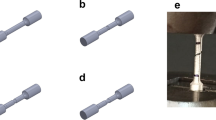A simulated coarse-grained heat affected zone microstructure formation mechanism is established in high strength low alloy steels using electron backscatter diffraction (EBSD). The governing effect of dispersion and ratios between different types of ferritic structural constituents on variation in impact strength is demonstrated. It is assumed from results of simulating a heat affected zone coarse-grained area that a reduction in welding energy input leads to a shift in ductile-brittle transition temperature towards a lower temperature.











Similar content being viewed by others
References
B. F. Grabin and A. V. Denisenko, Materials Science of Welding Low- and Medium-Alloy Steels [in Russian], Naukovo Dumka, Keiev 91978).
I. Grivnyak, Steel Weldability [in Russian], Mashinostroenie, Moscow (1984)
P. Seyffarth, Atlas Schweifl-ZTU-Schaubilder, Dusseldorf (Germany) (1982).
F. Heisterkamp, K. Hulka, and D. Batte, Metallurgy Welding and Qualification of Microalloyed (HSLA) Steel Weldments. AWS, Miami (Fl) (1990).
P. P. Stepanov, V. N. Zikeev, L. I. Éfron, I. I. Frantov, and Yu. D. Morozov, “Improvement of steel weldability for thick-walled gas pipelines of considerable diameter by optimizing chemical composition,” Metallurg, No. 11, 62–67 (2010).
F. Matsuda, K. Ikeuchi, Y. Fukada, Y. Horii, H. Okada, T. Shiwaku, C. Shiga, and S. Suzuki, “Review of mechanical and metallurgical investigations of M-A constituent in welded joint in Japan,” Trans. JWRI, 24, No. 1, 1–24 (1995).
W. W. Xu, Q. F. Wang, T. Pan, H. Su, and C. F. Yang, “Effect of welding heat input on simulated HAZ microstructure toughness of a V–N microalloyed steel,” in: Proceedings of Sino-Swedish Structural Materials Symposium (2007), pp. 234–239.
C. Shang, X. Wang, Q. Liu, and J. Fu, “Weldability of higher niobium x80 pipeline steel,” in: Proceedings of the International Seminar on Welding of High Strength pipeline Steels CBMM and TMS (2013), pp. 435–453.
M. Mandal, W. J. Poole, T. Garcin, M. Militzer, and L. Collins, “Mechanical behaviour of intercritically reheated coarse-grained heat affected zone in high strength line pipe steels,” in: Proceedings of the 2018 12th Int. Pipeline Conf. IPC 2018 (September 24–28, 2018. Calgary, Alberta, Canada).
T. Araki, K. Shibata, and M. Enomoto, “Reviewed concept on the microstructural identification and terminology of low carbon ferrous bainites,” Material Science Forum, 56–58, 225–280 (1990).
T. Araki, M. Enomoto, and K. Shibata, “Microstructural aspects of bainitic and bainitic-like ferritic structures of continuously cooled low carbon (< 0.3%) HSLA,” Materials Transactions JIM, 32, 729–736 (1991).
S. W. Thompson and G. Krauss, “Ferritic microstructures in continuously cooled low- and ultralow-carbon steels,” ISIJ International, 35, 937–945 (1995).
A.-F. Gourgues, H. M. Flower, and T. C. Lindley, “Electron backscattering diffraction study of acicular ferrite, bainite, and martensite steel microstructures,” Materials Science and Technology, 16, 24–40 (2000).
N. Takayama, G. Miyamoto, and T. Furuhara, “Effects of transformation temperature on variant grouping of bainitic ferrite in low carbon steel,” Solid State Phenomena, 172–174, 155–160 (2011).
J. M. Reichert, M. Militzer, W. J. Poole, and L. Collins, “A new approach using EBSD to quantitatively distinguish complex transformation products along the HAZ in X80 linepipe steel,” in: Proceedings of the IPC 2014-33668 (September 29 – October 3, 2014, Calgary, Alberta, Canada).
I. I. Frantov, T. S. Kireeva, and V. I. Stolyarov, “Problems of steel weldability with polymorphic transformations,” in: Contemporary Metallurgy Problems [in Russian], Metallurgiya, Moscow (1983).
V. A. Kharkin, Heating Processes During Welding [in Russian], Izd. Politech. Univ., St. Petersburg (2013).
GOSТ 9454–78. Metals. Impact Bending Test Method at Reduced, Room, and Elevated Temperatures (with Changes Nos. 1, 2) Izd. Standartov, Moscow (1994).
S. Zajac, V. Shwinn, and K. H. Tacke, “Characterization and quantification of complex bainitic microstructures in high and ultrahigh strength linepipe steels,” Materials Science Forum, 500–501, 387–394 (2005).
E. Keehan, L. Karlsson, H. K. D. H. Bhadeshia, and M. Thuvander, “Electron backscattering diffraction study of coalesced bainite in high strength steel weld metals,” Materials Science and Technology, 24, No. 10, 1183–1188 (2008).
B. Guo, L. Fan, Q. Wang, Z. Fu, Q. Wang, and F. Zhang, “The role of the bainitic packet in control of impact toughness in a simulated CGHAZ of X90 pipeline steel,” Metals, 6, No. 11, 256 (2016).
M. Kh. Shorshorov, Steel and Titanium Alloy Welding [in Russian] Nauka, Moscow (1965).
Author information
Authors and Affiliations
Corresponding author
Additional information
Translated from Metallurg, Vol. 64, No. 9, pp. 26–33, September, 2020.
Rights and permissions
About this article
Cite this article
Vorkachev, K.G., Stepanov, P.P., Éfron, L.I. et al. Effect of Microstructure on High-Strength Low-Alloy Steel Welded Joint Toughness with Simulation of Heat-Affected Zone Coarse-Grained Area. Metallurgist 64, 875–884 (2021). https://doi.org/10.1007/s11015-021-01067-3
Received:
Published:
Issue Date:
DOI: https://doi.org/10.1007/s11015-021-01067-3




